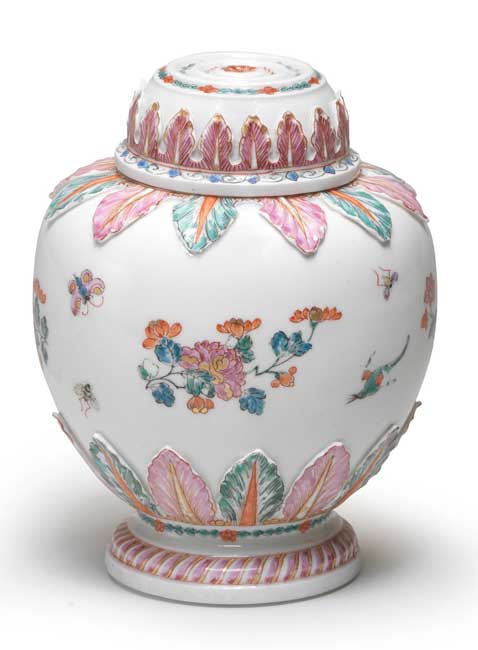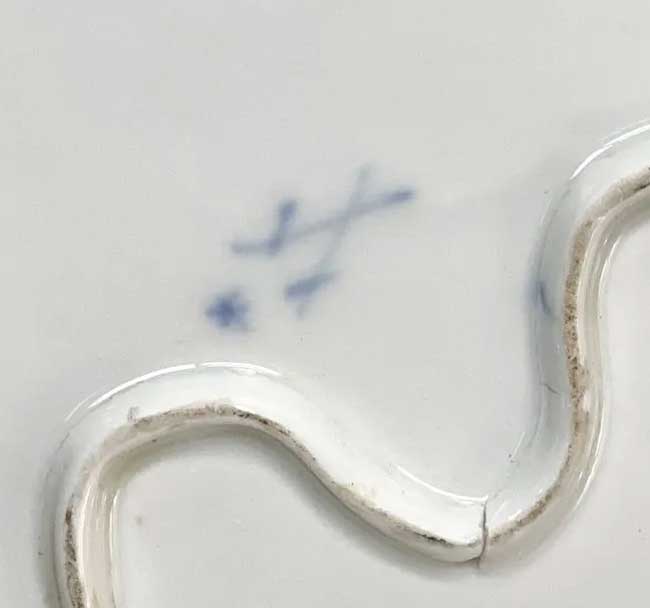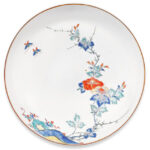Meissen porcelain or Meissen china was the first European hard-paste porcelain. Early experiments were done in 1708 by Ehrenfried Walther von Tschirnhaus. After his death that October, Johann Friedrich Böttger continued von Tschirnhaus’s work and brought this type of porcelain to the market, financed by Augustus the Strong, King of Poland and Elector of Saxony. The production of porcelain in the royal factory at Meissen, near Dresden, started in 1710 and attracted artists and artisans to establish, arguably, the most famous porcelain manufacturer known throughout the world. Reference: Wikipedia
Below are some examples and price guides of Meissen porcelain antiques including an example of the crossed swords maker’s mark and an armorial beaker and saucer

A rare early Meissen Dutch-decorated vase and cover, circa 1715-20, the decoration slightly later
Of ovoid form, painted with flower sprays alternating with birds, insects and butterflies, the moulded stiff-leaf borders painted in puce, iron-red and gilding, alternating with green, black and iron-red, the foot painted with a puce and gilt spiral band, the cover with a moulded stiff-leaf border painted in puce, iron-red and gilding, with formal foliate borders to the rim and top, 15.2cm high (very minor wear to enamels and gilding)
Sold for £3,570 inc. premium at Bonham’s in 2022

Meissen Porcelain Two-Handled Chinoiserie Beaker and a Saucer
Circa 1730, blue crossed swords marks and gilder’s 3. or 5., both painted in the manner of J.G. Höroldt
The tapering conical beaker flanked by gilt wishbone handles, finely painted with either a Chinese figure seated at a table before a palm tree or with figures pursuing butterflies, the saucer with two figure preparing and serving tea, each within an ombrierte quatrefoil shaped panel edged by a Böttger-lustre and a gilt cartouche, trimmed with iron-red scrollwork, the border with Laub-und-Bandelwerk and gilt line rims, the underside with iron-red flower sprays.
Height 3 1/8 inches, width overall 5 1/2 inches.
Sold for $3,150 (includes buyer’s premium) at Doyle in 2021

German porcelain triangular serving dish with ornithological decoration by Meissen. Scalloped rimmed with hand painted birds, butterflies, insects, and floral garlands throughout. Meissen Marcolini mark to the undersides, circa 1800.
Weight Approx., 1.5 lbs Measures Approx., 11.25 inches x 12.25 inches
Sold for US$600 at Taylor & Harris in 2022

A Meissen armorial beaker and saucer, Circa 1735
the beaker painted on the front with the arms of the Counts Micheil of Venice and on the reverse with figures fishing on a rocky bank, a large gold-scaled fish caught by one, the centre of the saucer with figure in a garden holding a basket and below the rim with two vignettes of figures seated upon rockwork, a butterfly and a flower sprig, the rims with gilt patterned borders trailing flower sprigs above the coat-of-arms, crossed swords marks in underglaze blue.
Diameter of saucer: 5 ⅛ in.
13 cm
Sold for 75,600 USD at Sotheby’s in 2021



